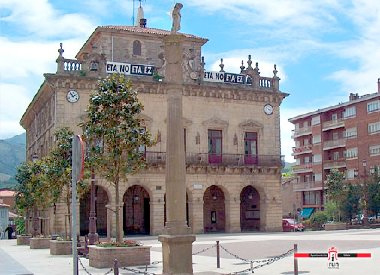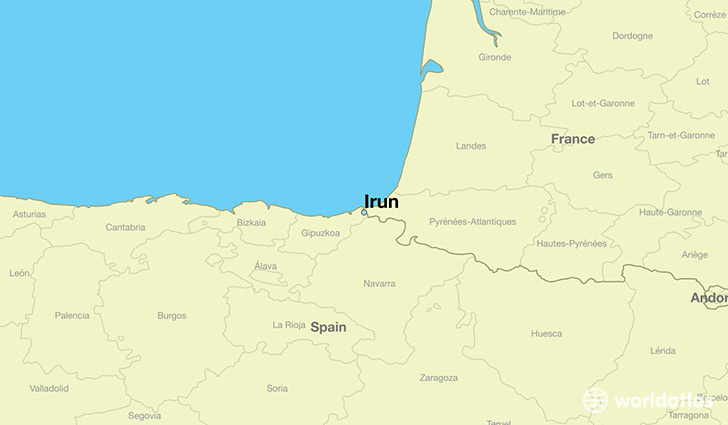
“We'll spend a night in Irun on our way to
Madrid ,” Bee, my travelling companion
announced with a dictatorial finality.
“Irun???”
“Its
in the Basque region of Spain.” The words jolted my memory like a tsunami wave bringing forth facts and figures which I had taught as a teacher.
Straddling
both France and Spain and partly in the Pyrenees ,with the Bay of Biscay to the north, it is inhabited by the Basque
people ,speaking a language( Euskara) distinct from
other European languages and having no linguistic relative. A very old race ,they have survived invasions ,
foreign domination and dictators. While most ethnic groups and sects in the Iberian Peninsula blended
into the main stream with the march of time , the insular Basque community
survived .
How did we reach Irun
How did we reach Irun
 |
| map showing parts of France and Spain, bay of Biscay |
At
7.30 in the morning we boarded the train
at Bordeaux heading for Hendeyne.Tickets are between 27 to 30 euros. Both stations are clean , signage is
clear and there are English –speaking staff at the information desk .The train
was spacious , enough room for luggage and filled with retirees and holiday
makers most of whom were heading for San Sebastian. Like most French trains there is a
catering facility, so the need to take
packed snacks does not arise. The
journey takes approximately 3 hours As we munched on our sandwiches and coffee
we took in the landscape while
traversing small towns , beautiful countryside
and picture -perfect vineyards .
We
reached Hendeyne at about 10.30. It is the farthest point of South –west France
, a frontier town before entering Spain . Despite the fact that the route is
traversed by thousands of people, since
it is the link between Iberian
Peninsular and the rest of Europe, the station is small, just about 4
platforms, so you’ll never get lost .
You
can walk across to Irun (Spain) from Hendeyne (France) across the Santiago
Bridge over the River Bidasoa. We, however, took a little train, after crossing
the frontier gate, running for just 6 mins.to reach Irun station. Thus we entered
the land of the Spanish Armada, flamenco dancers and the painter Francisco Goya nodding a “Hola”
to one and sundry.
Tip:
Train tickets fluctuate. Book your tickets well ahead to get fair discounts.
For short journeys take the regional trains (REC) than the TGV high speed. Although wash-room amenities are available in all stations sometimes you may have to make small payment.Therefore keep some ready change ready.
Where did we stay
For short journeys take the regional trains (REC) than the TGV high speed. Although wash-room amenities are available in all stations sometimes you may have to make small payment.Therefore keep some ready change ready.
Where did we stay
 |
| Bar Pension Restaurante Bidasoa |
We had an early morning train to Madrid. Therefore, we
decided on an accommodation just near the railway station and what better place
than “Bar Pension Restaurante Bidasoa” at 60euros per night . That was our
Paradise for the night.
I
have never stayed in a place like this.The name of the hotel was
self-explanatory; it is a bar frequented by the elderly pensioners at all times
of the day . Even at 10.30 it was pretty crowded. You can access the rooms of
the Pension(small hotel)through the bar and the restaurant lay beyond the
watering-hole.
Our tussle with the unknown began when we
realized that nobody could speak English though they understood us (I think). A
furtive look leapt into my eyes and my face contorted , witch-like, as it often does, when I am about to speak a
foreign language .
“ Senorita, Hemos reservado una habitacion aqui”(we have a reservation here) ,I said. Something went terribly wrong for the beautiful lady looked at us blankly and smiled. The accent must have been a pain to the ear like incoming artillery. Bee solved our problem by wielding the Google translator successfully. Smiling all the while she rattled off a string of incomprehensible sentences and called for the young Sou Chef, who knew communicative English, to settle the necessary modalities. “Una estancia confortable” she said . “Gracias.” Yes, we both understood.
The
room was small but very clean . The teeny-weeny bath-room had us “walking – in”
backwards. The invisible noise which was as soft as muslin coming from the
other room made us realise that the walls were thin. “Remember , you get what
you pay for,” I was told. Nevertheless we had a comfortable night , fresh for the next leg of our journey.
Tip: a) It’s good to know a few sentences of the local
language.
b)“Seista” is important for every Spaniard . Shops are shut and restaurants are closed. Therefore have your meals well ahead of time.
c)sncf.com/en and renfe.com/en are the two websites to check for train time-tables in France and Spain.
b)“Seista” is important for every Spaniard . Shops are shut and restaurants are closed. Therefore have your meals well ahead of time.
c)sncf.com/en and renfe.com/en are the two websites to check for train time-tables in France and Spain.
 |
| near our hotel |
What did we see and eat
Twenty hours is not
enough to see everything that Irun has to offer, with eight hours spent sleeping. We walked around taking
photographs of a few landmarks, visiting the shops,absorbing the sights,sounds
and flavours of the region.The spots we covered were the Town Hall and square , the church , the Palacio Arbelaiz . We didn't have time to go inside the Museo Romano Oiasso.
Proximity to the sea has made fish an important item in their menu apart
from local vegetables and meat .Tucking into the Marmitako (fish stew) and
Pintxos(finger food) along with a glass of Sangria ,our evening was made.
| Marmitako (fish stew) |
 |
| Sangria |
We
inter-acted with the elderly gentleman at the bookstore who made an interesting
statement ,“The Romans have come and gone but we are still here.” The region
has seen turbulent days during the revolutionary movement led by the ETA
(Euskadi Ta Azkatasuna meaning Basque country and Freedom) in the 1970’s saw
100 people dying every year.Violence had become an outdoor activity of the
people leading many Basque people to re-settle elsewhere.
Things have changed after the cease-fire in 2010 . Today the Spanish Basque Autonomous Country is more autonomous than many other parts of the continent, having the highest per capita income in Spain leading to immigration from poorer parts of Spain and the world. Though there are 30% fluent Basque speakers and 18% passive speakers, efforts are being made to revive the language. A beautiful country with beautiful people!
The
Evening saw groups of retirees entering the bar of the hotel which had three
screens telecasting football . Real Madrid was the popular club being cheered
,although I was told there is a team “Atheletic
Bilbao” where all players are Basque.The bonhomie at the bar was all pervading
with much laughter ,back-slapping and jokes in a language that was beyond our
reach. Beer did the rounds . We joined the cordiality and heartiness of the
folks before we called it a day.
Tip: a) Have time in hand to make a trip to San Sebastian , the nearby sea-resort.
‘ b)Be
a Roman in Rome”and do what the locals do.
c)Don’t be nostalgic about home-made food . Be
adventurous , dig and eat !!
 |
| My travelling partner, Bee |
Let me end with the words of Nelson Mandela:“After
climbing a great hill , one only finds that there are many more hills to
climb.”
No comments:
Post a Comment